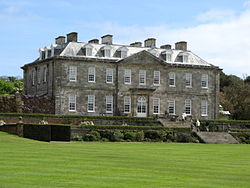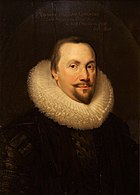Antony House
| Antony House | |
|
National Trust | |
|---|---|
 Antony House | |
| Grid reference: | SX418564 |
| Location: | 50°23’10"N, 4°13’34"W |
| Information | |
| Website: | Antony |
Antony House is a grand mansion standing in the Antony Estate on the Rame Peninsula of south-eastern Cornwall. The house and estate belong to the National Trust.
The estate is a mile and a half north-east of Antony village, on the north shore of the peninsula, a little before the Lynher or St Germans River enters the Hamoaze opposite Devonport. The Lynher estuary narrows a little here to make a clear flow and enabling the estate to have a jetty into the river.
The house was and remains the home of the Carew Pole family. It was developed as the family seat, a beautiful house in the classical style, faced in silver-grey Pentewan stone and flanked by colonnaded wings of mellow brick. It contains fine collections of paintings, furniture and textiles.
Part of the house and gardens are reserved to the family, but otherwise they are a National Trust property for the public.
Collections and furnishings

Antony House hosts a splendid collection of portraits, including a portrait of King Charles I at his trial, (Charles I granted a baronetcy to the Poles in 1628). The collection contains some of Sir Joshua Reynolds' works, and a portrait of Rachel Carew, believed to have inspired Daphne du Maurier's novel My Cousin Rachel.
Rooms are heavily panelled in Dutch Oak and contain fine collections of 18th-century furnishings and textiles.[1]
Gardens and estate
The grounds were landscaped by Georgian garden designer Humphry Repton and include the formal garden with the "National Collection of Day Lilies".[2] In the early 19th century, yew hedges and topiary were added to the formal landscaping.
Adorning the gardens are stone carvings from North West India, a Burmese temple bell brought to Antony by General Sir Reginald Pole Carew, statuary and more recently acquired modern sculptures, including the Antony Cone water sculpture by William Pye.[3] This echoes the grand spectacle of the topiary yew cone nearby, which is almost as tall as the house itself. Other sculptures include Jupiter Stone by Peter Randall-Page[4] and Hypercone by Simon Thomas.[5]
Other notable features include a black walnut tree, cork tree, a Japanese ornamental pond and knot garden. The dovecote dates from the 18th century, while a folly has been added recently in the estate grounds.
The surrounding woodland garden (not National Trust, but owned by the Carew Pole Garden Trust) is noted for rhododendrons, azaleas, camellias and magnolias, and surrounding woods provide delightful walks, which extend down to the river Lynher. The Bath Pond House situated in the woodland walks was built in 1789.
Film location
Filming for the 2010 Disney film production of Alice in Wonderland, directed by Tim Burton, took place in the grounds of Antony House in September 2008.[6]
The estate was also used as a location for a German television film in the series Rosamunde Pilcher.[7]
Outside links
| ("Wikimedia Commons" has material about House Antony House) |
- Antony - information at the National Trust
- Information on Antony House from GENUKI
- National Heritage List 1311081: Antony House
References
- ↑ Antony House at Plants.info
- ↑ Antony
- ↑ Williampye.com
- ↑ Where to See: Peter Randall-Page
- ↑ Simon Thomas: gallery
- ↑ http://www.gardensofcornwall.com/site/outdoor-kids/antony-house-and-garden-p133063
- ↑ Rosamunde Pilcher at the Internet Movie Database
